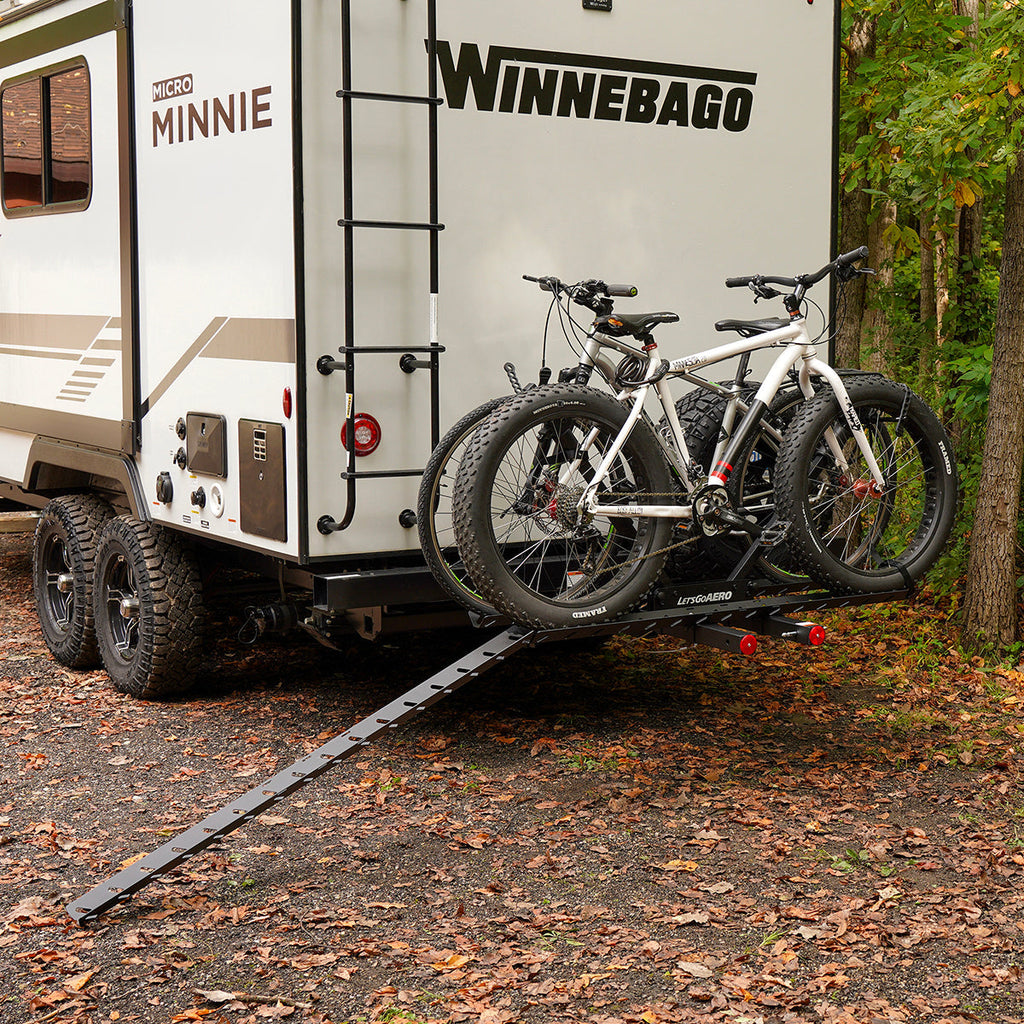Author: Amanda Kennedy
Published: March 26, 2025
Updated: March 26, 2025


When planning an RV trip, bringing along your bicycles can make your adventure even more enjoyable. However, not all bike racks are suitable for travel trailers. Many standard bike racks aren’t designed to withstand the unique forces that trailers experience on the road, leading to potential safety risks, damage, or even voided warranties.
In this guide, we’ll help you navigate the complexities of choosing the right bike rack for your travel trailer, avoid common mistakes, and ensure safe and hassle-free transport.

Before purchasing a bike rack, it’s crucial to verify whether it’s rated for use on travel trailers. Many bike carriers that work perfectly on passenger vehicles are not approved for RV use due to the unique stresses exerted on a rack when mounted on a travel trailer.
There are several types of bike carriers designed to work with travel trailers or 5th Wheels, each with its pros and cons.

A hitch-mounted bike rack is one of the most stable ways to transport bicycles on a travel trailer. It attaches directly to the hitch receiver, providing strong support and minimizing excessive movement during travel. As mentioned above, camper trailers experience more bounce and sway than motorhomes, so not all hitch bike racks are rated for RV trailer hitches. Whether you have light road bikes or big electric fat tire bikes, you will want to be sure your rack is rated not only for your bikes but for your vehicle as well.
✔ Pros:
✘ Cons:
 |
RV Rated Bike Carriers For a rock-solid, RV-rated bike solution, Let's Go Aero’s hitch-mounted bike racks are built to handle the unique demands of travel trailers. Featuring our TwinTube™ platform design, these racks offer unmatched stability and strength, reducing vibration and stress on your bikes. With models rated up to 80 lbs per bike with optional bike cover add-ons, they provide the durability needed to carry heavier loads securely, ensuring safe, worry-free transport for all your adventures. |

An A-frame bike rack mounts at the front of the trailer, providing one of the most stable environments for carrying bikes. Positioned over the trailer’s frame and hitch, this location minimizes bounce and sway, reducing stress on the rack and bikes. Since the rack sits at the front, bikes remain visible in the tow vehicle’s rearview mirror, allowing for easy monitoring while driving, so you can have peace of mind that your bikes remain safe. Additionally, this setup keeps the rear of the trailer open for cargo or other accessories and allows for add-ons like cargo trays for generators and lifts for easy bike loading.
✔ Pros:
✘ Cons:
 |
A-Frame Bike Mounts Jack-IT® bike racks let you transport bikes in previously unused space over your trailer’s A-frame, keeping the rear of your RV free for other cargo. With bikes positioned in front, you can see them in your rearview mirror, adding peace of mind while towing. Heavy-duty models are rated not only for travel trailers but also for electric bikes. Optional add-ons for additional gear and bikes expand your gear-hauling capabilities for even more adventure-ready storage. |

Most modern travel trailers either lack traditional steel bumpers or have lightweight bumpers not designed for load-bearing. Mounting a bike rack on an unsupported bumper can lead to bending, cracking, or failure, posing a safety risk. While aftermarket reinforcement kits exist, they are not a universal solution and should only be used if explicitly rated for standard bike transport and should never be used to transport heavier electric bicycles.
You can learn more about the dangers of RV bumper mounting and RV bike rack failures in our blog.
Ladder-mounted bike racks attach to the rear ladder of an RV, making them a solution for trailers without a hitch or A-frame mounting options. They work best for lightweight bikes but are not suitable for heavy e-bikes or multiple bikes. Since not all ladders are rated for dynamic loads, always check with the manufacturer before installation.
✔ Pros:
✘ Cons:

To ensure safe bike transport, avoid these common mistakes:

No, bike racks are not prohibited on RVs, but there are regulations and restrictions to be aware of:

When selecting a bike rack for your RV trailer, keep these factors in mind:
✅ Prioritize Stability and Security – Look for racks that offer strong attachment points, stable platforms, and Silent Hitch Pins that can handle the trailer’s movement.
✅ Choose RV-Rated Racks – Only select bike racks specifically approved by manufacturers for travel trailer use.
✅ Consider Ease of Loading and Unloading – Hitch and A-frame racks tend to be the most user-friendly, while ladder racks require more effort.
✅ Avoid Using Hitch Extensions – Hitch extensions and adapters increase motion on the hitch. Avoid using extensions and adapters, and always use an anti-rattle hitch device to remove extra motion.
Choosing the right bike rack for your travel trailer is crucial for safety, compliance, and convenience. By selecting an RV-approved rack, avoiding unstable mounting options, and following state regulations, you can enjoy worry-free bike transport on your next road trip.
Stay tuned for our recommendations on the best travel-trailer-compatible bike racks to make your adventures even better. 🚲🚐